Baltimore and Transit, a marriage made in hell?
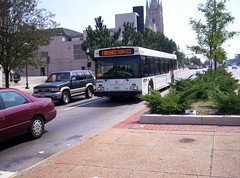 "Finished service" on North Avenue, Baltimore.
"Finished service" on North Avenue, Baltimore.This week's Baltimore City Paper has a disturbing article, "Dude, Where’s My Car? Abell Foundation Report Says Baltimore Has Worst Carlessness Rate in America."
The article has shades of what I described in a blog entry as "A really really bad article in the Washington Monthly," which suggested that the best way to get people out of poverty would be to give them cars. That article "A Car In Every Garage," argues that to end poverty, the best policy choice should be to give everyone a car, and she fails to address the factors, such as land use planning that allows job locations to be disconnected from efficient transit options, etc., which make car dependence a virtual necessity for many.
She wrote "To be a fully functioning citizen in this country today, a car is a virtual necessity; so the federal government should subsidize a set of wheels and the commute to work." At the same time, that article failed to take into account the extant subsidies for driving: a minimum of $300 billion/ year in the military budget related to maintaining access to foreign oil, 50% of the cost of roads, the provision of free parking to government workers, etc.
And as the Location Efficient Mortgage program makes very clear, by not being auto-dependent, and living on transit lines, families can cut spending on transit and put that money into buying a house. (The average household spends up to 20% of its annual income on automobile-related transportation.) House ownership builds the wealth generating capacity of households, car ownership does not.
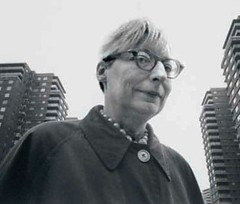 WWJJD? What would Jane Jacobs Do or Ask when it comes to urban questions?
WWJJD? What would Jane Jacobs Do or Ask when it comes to urban questions?Getting back to the closest I probably have to a deity that I willingly worship, Jane Jacobs, this is another instance of people asking the wrong question.
The right question is "If Baltimore seemingly has more public transportation options than many communities--light rail, subway, and bus--why is it so hard to get around the city efficiently, using transit?"
In fact, Paul Johnson wrote about this earlier in the month in his blog entry "MTA: Can’t get there from here."
Last March, in a blog entry entitled "The Six Reasons Why People Don't Ride Metro," I wrote about this in the context of DC, focusing on the subway, but the points are no less relevant to bus transit, as well as to the Baltimore situation. From the blog entry (slightly edited), The Six Reasons Why People Don't Ride Metro, are:
- It doesn't go where they need to go from where they are;
- It's not time-efficient;
- It's not cost-efficient to take public transportation compared to driving [note that a lot of the time this happens when parking is free];
- It goes where they need to go, and they would ride, if they could get to the station somewhat efficiently. Otherwise, it's easier or faster to drive. (This is related to but subtlely different from [2]);
- It can't be counted on; service interruptions mean it is no longer reliable when planning time-sensitive trips, and therefore another mode is chosen [this refers to the subway and train breakdowns, but it's true of bus transportation as well]; and
- It's not conducive to the requirements of the trip (parent with children, transporting something big and bulky, etc.).
The tone of the feature reflects the attitude that many people in the Baltimore area have that you are essentially not a full citizen without a car and that it's disturbing that 32% of all city residents do not have a car.
In DC, with our rich transit, walking, and increasingly cycling culture, this would be seen as a positive, but in Baltimore where the suburban car culture has taken full root, this is seen as a big impediment … and that the solution is to make it easier for city residents to drive so they can reach jobs that are mostly located in the suburbs. And what's particularly disturbing is that this story is in Baltimore's equivalent to the City Paper -- so you'd think they'd be progressive when it comes to issues of urban transport!
On my various excursions to Baltimore, I have always been struck over how much the city is oriented toward travel by private cars and how difficult it is to get around by any other mode -- except the tourist-oriented water taxi. The streets are designed for maximum Level of Service for suburban commuters [to speed through the city] and there is almost no shoulder space for cyclists. The transit that does exist is sporadic and discoordinated.

I bet that the great majority of carless people in Baltimore City are not so by choice, while an increasing number of the carless in DC are by choice. To me an ESSENTIAL indicator of a good vibrant urban place is where a car is either uncessary to get around or is a burden. After all, if you want a city where it’s easy to park and there's never much traffic congestion, Detroit wins hands down. Where would you rather spend a weekend? Detroit or Boston?
Steve, as usual, makes the right points. First, Baltimore thinks with suburban mobility paradigms (see the "Suburban Creep" blog entry from yesterday) rather than with urban mobility paradigms. Furthermore, Baltimore's transit doesn't work very well, it's "sporadic and discoordinated," so anybody who can afford a car buys one, and people who can't are abandoned to a relatively inefficient way to get around the region.
It is especially frustrating because the transit assets that Baltimore has are considerable, but are wasted because of mode disconnects, routing, and other issues, not to mention lack of some basic tools like web-based trip planning applications. PLUS, bus service appears to be infrequent, at least compared to the routes that I do ride in DC (90s, X2, 70s, S2, and the 30s but this busline is too infrequent for my taste).
There's something about transit in Maryland that I don't understand. For the most part, transit is funded and organized by the state government. (This has something to do with some tradeoff in the past, that counties would pay for something and in return the state would pay for something else.) Yet, Howard, Montgomery, and Prince George's Counties have independent bus systems that complement MTA or WMATA service.
I haven't gotten back to reading the draft revision of the Baltimore City Comprehensive Plan, so I don't know what it has in it about transit. It needs to be substantive. Dan Malouff pointed out the Baltimore Region Rail Transit Plan, but I haven't read that either (at least not yet). Having met one of the consultants involved in the planning for the Baltimore light rail "Red Line" I do know that the project is moving along, even if the "Purple Line," now called the Bi-County Transitway, is not.
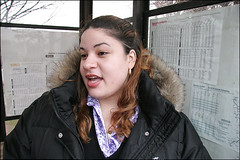 Julissa Freire, waiting at a Howard County Transit bus stop at Columbia Mall (note the schedules posted in the bus shelter). Washington Post photo by James M. Thresher. (See the Post article "Transit System Aiming to Assist Immigrants.")
Julissa Freire, waiting at a Howard County Transit bus stop at Columbia Mall (note the schedules posted in the bus shelter). Washington Post photo by James M. Thresher. (See the Post article "Transit System Aiming to Assist Immigrants.") OTOH, I think MTA does a nice job with bus shelters and routing information, at least they did before the "Greater Baltimore Bus Initiatives".
MTA has a major informational presence at Artscape, which is the kind of street-based event marketing that I think WMATA should do more of, but you can have the best information systems in the world and it matters not in the least if your product/service is deficient from the outset. (Note that I don't think MTA has the best information systems in the world, but they do some good things.)
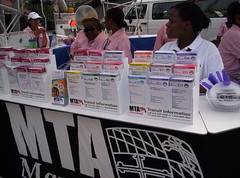
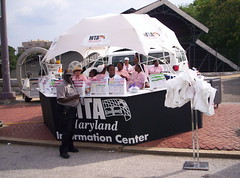 MTA presence at Artscape, July 2005.
MTA presence at Artscape, July 2005.The one day last May that I moved around the city by bus--going to places like Charles Village and Hampden--was not very much fun at all. I spent a fair amount of time sitting on my butt, waiting. And I didn't get to see very much as a result. I kept missing buses and the headways are long.
It was such a bad experience that when I went to Baltimore next, for Artscape (late July), I was determined to take my bike (via WMATA subway and the B30 bus, and MTA light rail from BWI). Only that way could I take in Lexington Market, Waverly, Hampden, and Artscape in one trip without a car. (See the blog entry Getting to Baltimore (and Artscape) with a bike.) That day, granted it was very hot, I don't recall seeing bicyclists.
___________
There has been a discussion of Urban Growth Boundaries on another e-list and it made me realize that I write as if UGBs are inextricably linked with transit. The fact is Portland Oregon, where this is so, is an exception. Samuel Staley, Director of Urban and Land Use Policy for the Reason Foundation, sums this up in a way that's also relevant to the above discussion about Baltimore transit, writing:
I'm not aware of any [UGBs] that were designed to include transit service. They are almost all driven by attempts to protect open space and manage infrastructure costs. Concerns about transportation are secondary. I think where the link comes is through density. In principle, UGBs should increase density, which should give transit a more competitive position. This isn't automatic. You still need an accessible transit system. It also helps if the transit system is well managed. Both are sorely lacking in most metro areas. (emphasis added)
Index Keywords: transit



0 Comments:
Post a Comment
<< Home